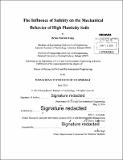| dc.contributor.advisor | John T. Germaine. | en_US |
| dc.contributor.author | Fahy, Brian Patrick | en_US |
| dc.contributor.other | Massachusetts Institute of Technology. Department of Civil and Environmental Engineering. | en_US |
| dc.date.accessioned | 2014-09-19T21:36:42Z | |
| dc.date.available | 2014-09-19T21:36:42Z | |
| dc.date.copyright | 2014 | en_US |
| dc.date.issued | 2014 | en_US |
| dc.identifier.uri | http://hdl.handle.net/1721.1/90049 | |
| dc.description | Thesis: S.M., Massachusetts Institute of Technology, Department of Civil and Environmental Engineering, 2014. | en_US |
| dc.description | Cataloged from PDF version of thesis. | en_US |
| dc.description | Includes bibliographical references (pages 235-238). | en_US |
| dc.description.abstract | This thesis investigates the influence of salinity on the mechanical behavior of smectitic rich high plasticity soils resedimented with pore fluid salinities ranging from 0 to 256 g/L. An extensive laboratory testing program involving Constant Rate of Strain (CRS) and K₀ consolidated undrained shear in compression triaxial testing (CK₀UC) was undertaken. Specimens tested in the modified CRS device reached axial effective stresses between 30 and 40 MPa. Triaxial testing was performed over a very wide range of effective stresses from 0.125 to 10 MPa, with one test consolidated to 63 MPa. Behavior is examined at pore fluid salinities of 4, 64, and 256 g/L. The shear behavior of all specimens was obtained in the normally consolidated region. Six different soils from the Gulf of Mexico region, ranging in liquid limit from 62 % to 90 %, were tested to determine the impact of varying salinity on one dimensional consolidation and permeability properties. The majority of testing was carried out on Gulf of Mexico - Eugene Island (GOM EI). This material was used to examine the behavior of a soil whose fabric has been changed by the removal of the natural salts via leaching. Both leached and natural GOM El were tested to investigate the influence of salinity on strength properties. CRS results show similar trends for each soil. Compressibility decreases and permeability increases significantly with increasing salinity. Increasing consolidation stresses to 40 MPa decreased the influence of salinity on compressibility to negligible levels while stress dependent permeability behavior varied amongst the soils tested. Significant decreases in both normalized undrained shear strength and critical state friction angle of GOM El with increasing stress level were observed, corresponding with an increase in the value of KO. An increase in shear strength and critical state friction angle was observed with increasing salinity at a consolidation stress of 0.4 MPa. No definitive trend was evident between the strength properties of leached and natural GOM El. The strength behavior of GOM El is consistent with that observed for other materials from a wide variety of geologic backgrounds and is in agreement with correlations between critical state friction angle and undrained strength to liquid limit. | en_US |
| dc.description.statementofresponsibility | by Brian Patrick Fahy. | en_US |
| dc.format.extent | 249 pages | en_US |
| dc.language.iso | eng | en_US |
| dc.publisher | Massachusetts Institute of Technology | en_US |
| dc.rights | M.I.T. theses are protected by copyright. They may be viewed from this source for any purpose, but reproduction or distribution in any format is prohibited without written permission. See provided URL for inquiries about permission. | en_US |
| dc.rights.uri | http://dspace.mit.edu/handle/1721.1/7582 | en_US |
| dc.subject | Civil and Environmental Engineering. | en_US |
| dc.title | The influence of salinity on the mechanical behavior of high plasticity soils | en_US |
| dc.type | Thesis | en_US |
| dc.description.degree | S.M. | en_US |
| dc.contributor.department | Massachusetts Institute of Technology. Department of Civil and Environmental Engineering | |
| dc.identifier.oclc | 890140097 | en_US |
